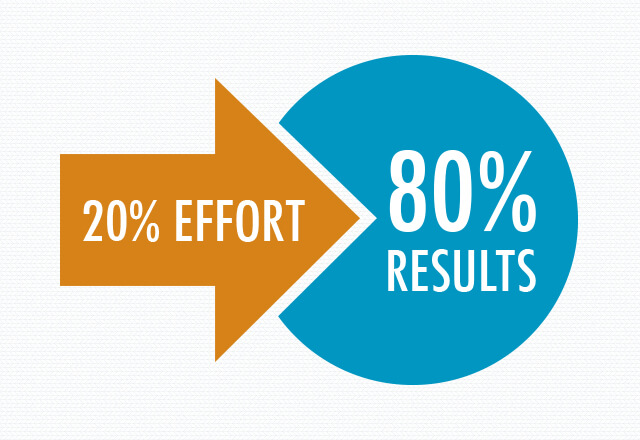 Updating your training methods as technology and systems change is crucial, so why are so many organizations behind on this front? In a lot of cases, it’s simply because they don’t know where to start – so they never do.
Updating your training methods as technology and systems change is crucial, so why are so many organizations behind on this front? In a lot of cases, it’s simply because they don’t know where to start – so they never do.
As a result, training is modified by workers in their day-to-day, often through tribal knowledge. This kind of training is full of gaps, leaving workers vulnerable to causing costly mistakes and accidents.
So how do you figure out where to start? Even if you’ve gotten as far as knowing you want to add current technology like 3D Interactive Simulation to your training, how do you decide which content and lessons need to be developed first?
The 80/20 Rule and how it impacts training
 A great way to find that starting point is by using the Pareto Principle. Also known as the 80/20 Rule, the Pareto Principle states that 20 percent of your resources are responsible for 80 percent of your results – for example, 20 percent of pea plants produce 80 percent of the peas in a garden, etc.
A great way to find that starting point is by using the Pareto Principle. Also known as the 80/20 Rule, the Pareto Principle states that 20 percent of your resources are responsible for 80 percent of your results – for example, 20 percent of pea plants produce 80 percent of the peas in a garden, etc.
With regard to training, there are a number of areas you can explore to determine where you are being 80 percent impacted – thereby revealing the 20 percent you should focus on first. One thing to understand: Pareto is a principle – not a hard and fast statistic. But it can guide you to understand where your organization’s strengths and weaknesses are.
Here are 6 powerful examples to illustrate how the Pareto Principle can transform your training, and keep you moving forward on the right track:
- 20 percent of the technicians make 80 percent of the mistakes. If this true in your company, is that 20 percent represented in new hires who need better training? It takes twice as long to correct something than to do it correctly in the first place, so if this is your issue it’s worth focusing on how to improve training straight out of the gate.
- 20 percent of the procedures cause 80 percent of the errors. If your problem is tribal knowledge, as referenced above, you need a clear system for all workers to follow – from new trainees to seasoned vets. Outdated training methods that don’t engage your workers could also be the problem here – it’s hard to learn and remember something if you zone out while it’s being taught.
- 20 percent of the equipment on the assembly line causes 80 percent of the production downtime. Are you pulling equipment off the production line to be used during training? Even losing fraction of your equipment for a short period of time can result in major slowdowns – especially if it gets broken due to misuse or wear and tear. 3D interactive simulation solves this by getting trainees up to speed with ‘practice-anywhere’ virtual replicas of workplace equipment. By the time they train and work with the real thing, they’ve got the foundation knowledge and skills to use it properly.
- 20 percent of your customers represent 80 percent of your training support and service volume. If 20 percent of your customers are dissatisfied with your customer support or tech services, that’s a large enough pool to infect a lot of people with negative thoughts about your company – especially if they talk on social media. This training is super important for consumer-facing departments.
- O&M Technicians spend 80 percent of their time on 20 percent of the equipment’s features. If this is true, they should know the features represented by that 20 percent inside and out – and perhaps not focus as heavily on other features. It’s important to prioritize training goals so you don’t waste time on procedures that don’t matter. One thing 3D simulation offers is the opportunity to refresh quickly at any time, making that 80 percent of additional knowledge easy to access when needed.
- 20 percent of the hazards in a workplace cause 80 percent of the injuries. This perfectly illustrates how being improperly trained in just a few procedures can have exponential impact. But you don’t have to fix everything at once – you have to decide what 20 percent is causing the biggest problem, and fix it first.
The statements above are just some areas and topics that might need updating within your organization’s training program – and you may have other issues that take greater priority. Using the 80/20 Rule helps you decide where to focus your efforts as you create a roadmap to deploy visual, interactive and portable training solutions for those problems.
When you do, you’ll find your training is not only easier to dispense across your organization, it’s far more effective and economical. That makes it worth taking the time to update, doesn’t it?
For a no-obligation discussion around your unique needs, contact us here now!


